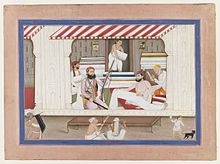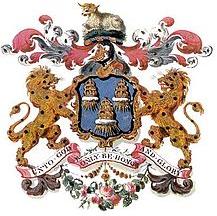MY FIRST FIVE.......!
THE FIVE THINGS I WANT TO START WITH
There are considerable overlaps between the terms clothing-/garment-, textile- and fashion industry. The clothing sector is concerned with all types of clothes, from fashion to uniforms, e-textiles and work wear. Textile industry is less concerned with the fashion aspect but produces the fabrics and fibres that are required for tailoring. The fashion industry closely follows - and sets - fashion trends to always supply the latest in non-functional clothing.
RETAIL TALK
In the Middle Ages or 16th and 17th centuries, a cloth merchant was one who owned or ran a cloth (often wool) manufacturing or wholesale import or export business. A cloth merchant might additionally have owned a number of draper's shops. Cloth was extremely expensive and cloth merchants were often very wealthy. A number of Europe's leading banking dynasties such as Medici and Berenberg built their original fortunes as cloth merchants.
Cloth merchant
In England, cloth merchants might be members of one of the important trade guilds, such as the Worshipful Company of Drapers.
Alternative names are clothier, which tended to refer more to someone engaged in production and the sale of cloth, whereas a cloth merchant would be more concerned with distribution, including overseas trade, or haberdasher, who were merchants in sewn and fine fabrics (e.g. silk) and in London, members of the Haberdashers' Company.
The largely obsolete term merchant taylor also describes a business person who trades in textiles, and initially a tailor who keeps and sells materials for the garments which he makes. In England, the term is best known in the context of the Worshipful Company of Merchant Taylors, one of the livery companies of the City of London, nowadays a charitable institution best known for the Merchant Taylors' schools - the Company preserves the ancient spelling "taylor" in its name.
SOME NOTABLE CLOTH MERCHANTS
Alderman Robert Aske
Sir William Gardiner
John Kendrick
Henry Machyn, diarist
Jack O'Newbury
William Paterson
Thomas Spring of Lavenham
Sir Thomas White
Drapers
Draper was originally a term for a retailer or wholesaler of cloth that was mainly for clothing. A draper may additionally operate as a cloth merchant or a haberdasher.
Drapers were an important trade guild during the medieval period, when the sellers of cloth operated out of draper's shops.[citation needed] However the original meaning of the term has now largely fallen out of use.
In 1724, Jonathan Swift wrote a series of satirical pamphlets in the guise of a draper called the Drapier's Letters.
A number of notable people who have at one time or another worked as drapers include:
Sir Thomas Adams, 1st Baronet
Norman Birkett
Margaret Bondfield
Eleanor Coade (1733–1821), successful businesswoman with Coade stone
Harry S. Truman, haberdasher before he became a Senator, Vice President and President
Antonie van Leeuwenhoek
John Spedan Lewis
Anthony Munday
Thomas Burberry, Founder of fashion brand "Burberry"
H. G. Wells
George Williams, founder of the YMCA[1]
John Woodward, geologist and physician to King Charles II
John Graunt, founder of the science of demography
A draper is now defined as a highly skilled role within the fashion industry. The term is used within a fashion design or costume design studio for people tasked with creating garments or patterns by draping fabric over a dress form; draping uses a human form to physically position the cloth into a desired pattern. This is an alternative method to drafting, when the garment is initially worked out from measurements on paper.
 A fashion draper may also be known as a "first hand" because they are often the most skilled creator in the workshop and the "first" to work with the cloth for a garment. However a first hand in a costume studio is often an assistant to the draper. They are responsible for cutting the fabric with the patterns and assisting in costume fittings.
A fashion draper may also be known as a "first hand" because they are often the most skilled creator in the workshop and the "first" to work with the cloth for a garment. However a first hand in a costume studio is often an assistant to the draper. They are responsible for cutting the fabric with the patterns and assisting in costume fittings.
The Worshipful Company of Drapers is one of the 110 livery companies of the City of London. It has the formal name The Master and Wardens and Brethren and Sisters of the Guild or Fraternity of the Blessed Mary the Virgin of the Mystery of Drapers of the City of London. More usually known simply as the Drapers' Company, it is one of the historic Great Twelve Livery Companies and was founded during the Middle Ages.
Haberdasher
The word appears in Chaucer's Canterbury Tales.Haberdashers were initially peddlers, thus sellers of small items such as needles and buttons. The word is not thought to have connection with an Old Norse word akin to the Icelandic hafurtask, which means "peddlers' wares" or the sack in which the peddler carried them.If that had been the case, a haberdasher (in its hypothetical Scandinavian meaning) would be very close to a mercier
(French).
Since the word has no recorded use in Scandinavia, it is most likely derived from the Anglo-Norman hapertas, meaning "small ware". A haberdasher would retail small wares, the goods of the peddler, while a mercer would specialize in "linens, silks, fustian, worsted piece-goods and bedding".
Saint Louis IX, King of France 1226–70, is the patron saint of French haberdashers. In Belgium and elsewhere in Continental Europe, Saint Nicholas remains their patron saint, while Saint Catherine was adopted by the Worshipful Company of Haberdashers in the City of London.
Worshipful Company of Girdlers
The Worshipful Company of Girdlers is one of the Livery Companies of the City of London.
 Girdlers were granted the right to regulate their trade in the City from 1327 and obtained a Royal Charter in 1449. Girdlers, or makers of belts and girdles, are no longer closely related to their original trade. Along with the products of many other Livery Companies, girdles have become of less importance than in medieval times. However, the Company continues its long tradition as a charitable body.
Girdlers were granted the right to regulate their trade in the City from 1327 and obtained a Royal Charter in 1449. Girdlers, or makers of belts and girdles, are no longer closely related to their original trade. Along with the products of many other Livery Companies, girdles have become of less importance than in medieval times. However, the Company continues its long tradition as a charitable body.
The Girdlers' Company ranks twenty-third in the order of precedence of City Livery Companies. The Company's motto is Give Thanks To God.







Comments